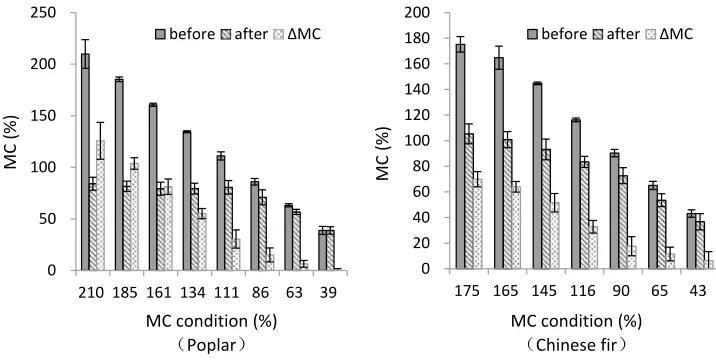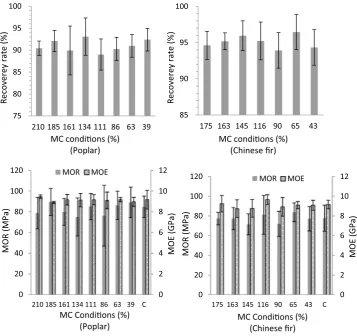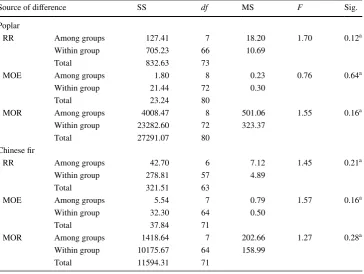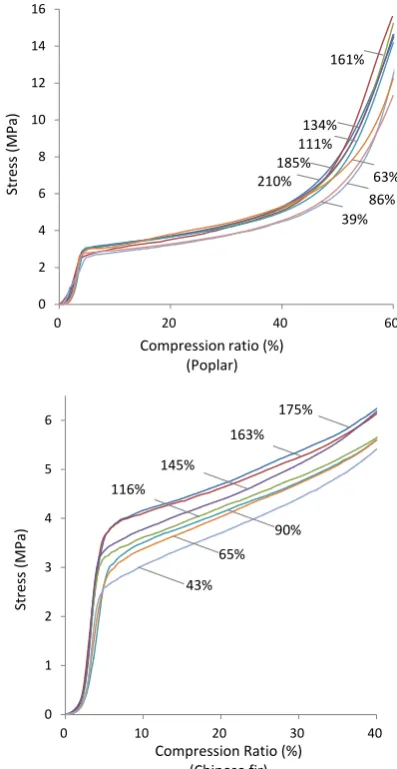ORIGINAL ARTICLE
Studies on pre-treatment by compression for wood drying
III: the reduction of moisture content, the recovery rate,
and mechanical properties of wood compressed at different
moisture content conditions
Youke Zhao1
Received: 9 December 2016 / Accepted: 15 January 2017 / Published online: 1 March 2017 © The Japan Wood Research Society 2017
Introduction
In conventional thermal drying, the energy used for evap-orating the water accounts for most of the energy, and a longer time is needed to dry materials with high moisture content (MC). Removing water by mechanical compression uses less energy and time because no energy is consumed for water vaporing and the mechanical pressure process can be finished in a rather short time. Therefore, mechani-cal dewatering, usually combined with simultaneous ther-mal drying [1–3], as well as the changes of porous struc-ture caused by mechanical treatment [4–6] has been studied for drying sorts of internally porous biomaterials. As one of the most important bio-resource materials, the wood has also been tested for dewatering by means of mechani-cal compression in the form of veneer [7], wood chips [8], and solid wood [9–12]. In the forms of veneer and wood chips, the ideally MC can be reached by mechanical com-pression and simultaneous thermal drying because of the very limited thickness of veneer and the size of chips. In the form of solid wood with high MC, the ideal MC is hard to be reached, although the MC reduction by this mechani-cal dewatering is very effective, while the simultaneous thermal treatment is hardly working because of the very big size of solid wood and very short time for mechani-cal treatment. However, the mechanimechani-cal treatment for solid wood becomes very useful in practical wood drying when it is used as a pre-treatment for wood drying. In this way, the MC could be greatly reduced in a very short time; the energy for following drying can be saved which is benefited from decreased MC and increased MC flow paths by this mechanical treatment. In addition, a long time of air drying used could be avoided or reduced; therefore, not only could the speed of recouping the fund be accelerated as a result of shortened cycle of wood industry procedure, but also the
Abstract As a follow-up report, the pre-treatment by compression for wood drying was systematically studied in terms of the reduction of moisture content (MC), the recov-ery rate (RR), and mechanical properties of wood com-pressed at different MC conditions. The results showed that MC after compression on water-saturated wood determined the critical value of MC before compression which were about 84 and 105% at a compression ratio of 60 and 40% for Poplar and Chinese fir, respectively. Beyond the critical value, MC after compression remained constantly at about 84% and decreased slightly from 105% for Poplar and Chi-nese fir, respectively. The MC reduction decreased with the decrease of MC before compression. The MC reduc-tion was rather effective when the MC before compression was higher than the critical value and was recommended to pre-treat for the effectiveness of MC reduction. In addi-tion, after the recovery, the wood volume and mechanical properties were well retained for the wood compressed at all MC conditions which were above fiber saturation point (FSP) before and after compression. Therefore, the pre-treatment by compression is viable in terms of the RR and mechanical properties at rather broad MC conditions above FSP. Moreover, the compression force needed for treatment was almost same at these MC conditions.
Keywords Pre-treatment · Compression · Moisture content · Recovery rate · Mechanical properties
* Youke Zhao
youke_zhao@hotmail.com
development of the blue stain during air drying could be avoided or reduced.
A series of previous reports published recently [13, 14] showed that not only could the MC of wood be very effectively reduced, but also the volume and the strength of wood could be rather well retained after the pre-treatment by compression. All these reports were based on the water-saturated condition to facilitate the studies of effects of compression ratio, compression direction, and compression speed on MC reduction, the recovery rate, and mechani-cal properties. In this way, the effects from MC variation between individuals could be minimized. A systematical study is needed to know how efficiently the MC will be reduced for the wood compressed at different MC condi-tions. In other words, it should be clear that at what range of MC this treatment is still effective in MC reduction. One more concern is the effects of MC during compression on the recovery rate (RR) of wood and on the mechanical properties. During the pre-treatment by compression, the MC decreased differently in amount for wood at different MC conditions; the bonds between wood constituents and the bonds between wood and water were replaced by each other repeatedly. In this dynamic course, it is necessary to know how the RR and mechanical properties are affected under the large deformation compression (60 and 40% compression ratio for Poplar and Chinese fir, respectively) at the given speed of compression. Therefore, the purpose of this study is to systematically study the reduction of MC, recovery rate, and mechanical properties of wood com-pressed at different moisture content conditions ranging from water-saturated condition to a bit above fiber satura-tion point (FSP).
Materials and methods
Five trees of 10-year-old Poplar (Populus euramevicana
cv. ‘I-214’) plantation grown in the side of a pond with the diameter at the breast height of about 30 cm, the ini-tial MC of about 200%, and the basic density of 0.32 g/ cm3, and about 5 m3 of Chinese fir (Cunninghamia lanceo-lata) plantation from local market with the basic density of 0.31 g/cm3, were collected from Taihu County of Anhui
Province. The specimens were prepared with the size of 30 mm (R) × 50 mm (T) × 100 mm (L) and tested in radial compression.
All the specimens were vacuum pressure-treated so that all the specimens were fully water-saturated. Then, they were subjected to a slow MC loss in a very humid cham-ber until the MC reached the set value; then, the specimens were packed tightly in air-tight plastic film and stored in a refrigerator to make the MC evenly distributed. The MC was determined by the weight of the specimen and its dry
weight. The dry weight was calculated by the volume of the specimen itself and the basic density of a physically lon-gitudinal connected specimen. The MC was set in 8 and 7 levels from saturated MC to about 40% for Poplar and Chi-nese fir, respectively. Ten repeats of specimen for each MC level were prepared and tested.
The compression was easily completed by a fully com-puter-controlled Instron 5582 Universal Test Machine at a speed of 3 and 5 mm/min, and a compression ratio at 60 and 40% for Poplar and Chinese fir, respectively. The speed and the ratio were determined by previous report [13]. A special adapter was connected to the compression head to facilitate the compression.
The thicknesses along the compression direction of specimens were measured, respectively, before compres-sion and after the release of comprescompres-sion load when the specimens were fully recovered. The RR was calculated by recovered size divided by the compressed size and expressed in percentage.
The specimens for mechanical properties tests were pre-pared with the size of 4 mm (T) × 10 mm (R) × 100 mm (L) after the compression was unloaded, and the woods were recovered and air-dried. In this way (L/T ≧20), the size effect could be ignored. The specimens were conditioned at 20 °C and RH 65% for a constant weight. The modu-lus of rupture (MOR) and modumodu-lus of elasticity (MOE) in static bending were measured with a YAW-3000A Univer-sal Testing Machine at a span of 80 mm and the load head radius of 5 mm.
Results and discussion
Reduction of MC of wood compressed at different MC conditions
MC before compression, after compression, and the reduc-tion of MC of wood compressed at different MC condireduc-tions are shown in Fig. 1.
For Poplar, the MC after compression of wood remained constantly at about 80% when the wood was compressed at a MC condition of more than 86%; it decreased gradually when the wood was compressed at a MC condition lower than 86%. As a result, the reduction of MC decreased with the decrease of MC condition. For example, the reduction of MC was reduced from 125.7% to almost nothing when the MC condition was decreased from 210 to 38%.
slightly decreased from 105.3 to 83.4% when the MC con-dition was decreased from 175 to 116%, while was gradu-ally decreased from 72.7 to 37.7% when the MC conditions were 90 and 43%, respectively. The reduction of MC was reduced from 69.9 to 6.4% when the MC condition was decreased from 175 to 43.1%.
At water-saturated condition, the reduction of MC pro-portionally increases with the increase of compression ratio [13]. This means the MC after compression is determined for a given compression ratio. In this study, the MC after compression for Poplar and Chinese fir were, respectively, 84.1 and 105.3%, a critical value of MC threshold before compression: above this threshold value, the MC after com-pression would be reduced to similar level since the same compression ratio allows the similar maximum amount of water, and below this threshold the MC after compres-sion would not reach the allowed maximum amount and therefore would be reduced. This explains the MC after compression of wood that remained constant or decreased slightly when the MC were beyond 85 and 116% for Pop-lar and Chinese fir, respectively. The critical value in early report [13] was about 75% and 120% for a different species of Poplar (Populus tomentosa) and the same species of Chi-nese fir grown in different provinces.
When the wood is not in water-saturated condition, the air will occupy some space of lumen and will deter the reduction of MC during compression. Compared to the tracheid and pit of Chinese fir, the vessel and perforate in Poplar are big in size; the air which owns a less viscosity than water readily and easily moves out of wood in Poplar and therefore is less likely to affect the MC after compres-sion. In addition, according to the early study, the compris-able ratio ranged from 46.02 to 50.27 and from 56.11 to 59.06% for Poplar and Chinese fir, respectively, based on the assumption that all the voids in wood could be totally compressed [13]. The compression ratio in this study were 60 and 40% for Poplar and Chinese fir, respectively;
therefore, the cell walls were closely contacted with each other in Poplar, while the voids still existed in Chinese fir. The water-to-air proportion in the voids after compres-sion was determined by the MC before comprescompres-sion. This explains why the MC after compression in Poplar remained almost constant beyond the critical value of MC while that decreased slightly in Chinese fir.
As shown in Fig. 1, the MC reduction was rather effec-tive when the MC before compression was higher than the critical value. Therefore, it is recommended to pre-treat the wood when the MC before compression is higher than the critical value; otherwise, the MC reduction is rather limited.
Recovery rate and mechanical properties of wood compressed at different MC conditions
RR and mechanical properties of wood compressed at different MC conditions showed there were no clear pat-terns of both recovery rate and mechanical properties with relation to the MC condition at the range of 210–39 and 175–43% for Poplar and Chinese fir, respectively (Fig. 2).
At all the MC ranges tested, the RR was no less than 89.0 and 93.9% for Poplar and Chinese fir, respectively, suggesting that the wood volume was well retained after the compression at all the MC conditions tested; therefore, the pre-treatment by compression is viable in terms of the recovery rate when the wood was compressed above the FSP.
At all the MC ranges tested, the MOR and MOE accounted 88.4–105.4 and 97.0–103.2% that of con-trolled specimen (not compressed) for Poplar and that of 92.1–107.9 and 95.3–105.5% for Chinese fir, suggesting that the mechanical properties were well retained after the treatment by compression. It concluded that the pre-treat-ment by compression is viable in terms of the mechanical properties when the wood was compressed above FSP.
Fig. 1 Moisture content (MC) before/after compression and the reduction of MC (ΔMC) of wood compressed at differ-ent MC conditions (error bar standard deviation)
0 50 100 150 200 250
210 185 161 134 111 86 63 39 before after ∆MC
MC (%
)
MC condition (%)
˄Poplar˅
0 20 40 60 80 100 120 140 160 180 200
175 165 145 116 90 65 43 before after ∆MC
MC
(%)
MC condition (%)
˄Chinese fir˅
The MC before and after compression of wood at differ-ent MC conditions was all higher than FSP (Fig. 1). This meant there were abundant and enough water molecules to bond with matrix of lignin and hemicellulose, which enlarged the gap between wood molecules and reduced the amount of “Velcro” hooks of hemicellulose side chains and cellulose fibrils that entangled with the rest of matrix [15]. The modulus in nearly saturated hemicellulose was found almost three orders of magnitude smaller than the nearly dry hemicellulose [16], suggesting that the resist-ance of recovery from hemicellulose in wet condition could be ignored. A surprising find that the lignin is involved in the stress transfer in the cell wall to a low degree [17] suggests that the recovering resistance from lignin is in low degree. The microfibril, which is not softened even at high MC, would store the energy of compression and would easily spring back with less resistance from softened matrix [18] and less “Velcro” hooks when the compression was released [19]. This explains the results in Fig. 2 that the wood could almost restore to the original size. Vari-ance analysis showed there was no significant difference between the RR of wood compressed in different MC con-ditions (Table 1).
During the compression and the recovery of wood, the bond between wood constituents and bond between wood and water were replaced by each other repeatedly. As a result, hemicelluloses that were attached to the cellulose fibrils entangled with the rest of lignin-rich matrix were disentangled and entangled in a series of new positions of the fibrils (like Velcro connection that has been opened and closed) [19]. The new position was locked after the com-pletion of wood cell movement, i.e., the recovery. The bond locked in new position might have the same strength as it did before compression. The microfibrils, the main fac-tor determining the mechanical properties, were unlikely changed during the compression treatment because they were less or not affected by moisture and the compression was perpendicular to them. In addition, the densification of pre-treated wood resulted from not total recovery, as well as possibly decreased microfibril angle caused by compres-sion, would benefit the improvement of mechanical proper-ties. This explains the results in Fig. 2 that the mechanical properties retained well even at such a high compression ratio. Analysis of variance showed there was no signifi-cant difference between the mechanical properties of wood compressed in different MC conditions (Table 1).
Fig. 2 Recovery rate and mechanical properties in static bending of wood compressed at different moisture content (MC) conditions (C controlled, MOR modulus of rupture, MOE modulus of elasticity, error bar standard deviation)
75 80 85 90 95 100
210 185 161 134 111 86 63 39 MC condions (%)
(Poplar)
Recoverey rate (%)
85 90 95 100
175 163 145 116 90 65 43 MC condions (%)
(Chinese fir)
Recoverey rate (%)
0 2 4 6 8 10 12
0 20 40 60 80 100 120
210 185 161 134 111 86 63 39 C
MOR MOE
MOR (MPa
)
MOE (GPa
)
MC Condions (%) (Poplar)
0 2 4 6 8 10 12
0 20 40 60 80 100 120
175 163 145 116 90 65 43 C
MOR MOE
MOR (MPa
)
MOE (GPa
)
Stress–strain curve during compression at different MC conditions
Stress–strain curve showed a similar trend for wood at different MC conditions (Fig. 3). Despite the fact that the stress compressed at high MC condition in Chinese fir was clearly a little bit higher and that in Poplar tended to be higher than that at low MC condition at the same compression strain (ratio), the wood at all these MC conditions showed a same characteristics in mechanical properties aspects. In another word, over a rather broad range of MC from over the FSP to saturated condition, the compression force needed for the pre-treatment was almost same; which is in favor of the practical treatment by compression. The fact that the stress in high MC con-dition tended to be a little bit higher at high MC condi-tion was probably due to more energy that was consumed for removing more water out of the wood. This agrees the conclusion that the transport of free water in the deform-ing wood is of major importance in the study of the stress–strain curve of compression of spruce wood [20]. This also explains to some extent that the curves at lower compression ratio, especially before the proportional limit, were closely overlapped as no energy was con-sumed for MC reduction because there was no MC reduc-tion at all during this state. Lower free space resulting
from higher MC condition was probably one more reason that the stress in high MC tended to be higher. Compared with Poplar with big difference in size of fiber and ves-sel, much even structure of tracheid in Chinese fir may explain to some extent that the stress in high MC condi-tion was clearly higher than that in low MC condicondi-tion, while the stress–strain curves in different MC conditions in Poplar overlapped at some compression ratios despite the fact that it tended to be higher in high MC condition (Fig. 3).
For Poplar, the curve was composed of three parts. At the beginning, the stress increased proportionally with the increase of compression strain (ratio); over the propor-tional limit, the radial wall of wood cell was bent under the radial compression, leading to the easy movement of the tangential wall from one to the other. As a result of this, the stress increased slowly. When the tangential wall contacted with each other, the stress increased again. As mentioned before, the cell walls has already contacted with each other before reaching the maximum compres-sion ratio (60 %) in Poplar, while the lumen void still existed even at the maximum compression ratio (40 %) in Chinese fir, that’s why the stress increased again for Pop-lar and only first two parts of the curve shown in Chinese fir (Fig. 3).
Table 1 Significance analysis on RR, MOR, and MOE of wood compressed at different MC conditions
a Not significant
RR recovery rate, MOE modulus of elasticity, MOR modulus of rupture, SS sum of squares, df degree of freedom, MS means square, F F test statistic, Sig. significance
Source of difference SS df MS F Sig.
Poplar
RR Among groups 127.41 7 18.20 1.70 0.12a
Within group 705.23 66 10.69
Total 832.63 73
MOE Among groups 1.80 8 0.23 0.76 0.64a
Within group 21.44 72 0.30
Total 23.24 80
MOR Among groups 4008.47 8 501.06 1.55 0.16a
Within group 23282.60 72 323.37
Total 27291.07 80
Chinese fir
RR Among groups 42.70 6 7.12 1.45 0.21a
Within group 278.81 57 4.89
Total 321.51 63
MOE Among groups 5.54 7 0.79 1.57 0.16a
Within group 32.30 64 0.50
Total 37.84 71
MOR Among groups 1418.64 7 202.66 1.27 0.28a
Within group 10175.67 64 158.99
Conclusions
MC after compression on water-saturated wood deter-mined the critical value of MC before compression which were about 84 and 105% at a compression ratio of 60 and 40% for Poplar and Chinese fir, respectively. Beyond the critical value, MC after compression remained con-stantly at about 84% and decreased slightly from 105% for Poplar and Chinese fir, respectively. The MC reduc-tion was rather effective when the MC before compres-sion was higher than the critical value, and therefore is recommended for the pre-treatment of wood in terms of effectiveness of MC reduction; otherwise, the MC reduc-tion is rather limited. The MC reducreduc-tion decreased with the decrease of MC before compression.
The wood volume and mechanical properties were well retained for the wood compressed at all MC condi-tions above FSP before and after compression, suggesting that the pre-treatment by compression is viable in terms of the RR and mechanical properties at rather broad MC conditions.
The compression force was also almost the same at these MC conditions, which is in favor of the practical treatment by compression.
Acknowledgements Author gratefully acknowledges the financial support from State Forestry Administration 948 Project (2011-4-19) and the laboratory assistance by Ms. Xin Zhao.
References
1. Clayton S, Scholes O, Hoadley AF, Wheeler R A, Mcintosh MJ, Huynh DQ (2006) Dewatering of biomaterials by mechanical thermal expression. Dry Technol 24:819–834
2. Unsal O, Candan Z (2008) Moisture content, vertical density profile and janka hardness of thermally compressed pine wood panels as a function of press pressure and temperature. Dry Technol 26:1165–1169
3. Stahl MR, Stahl WH (1999) Mechanical drying of timber—the new i/d-process. Dry Technol 17:56–57
4. Clayton S, Wheeler RA, Hoadley AF (2007) Pore destruction resulting from mechanical thermal expression. Dry Technol 25:533–546
5. Feng L, Tang J, Ma Z, Wan Y (2017) Effect of mechanical ther-mal expression drying technology on lignite structure. Dry Tech-nol 35:356–362
6. Watanabe U, Imamura Y, Iida I (1998) Liquid penetration of precompressed wood VI: anatomical characterization of pit frac-tures. J Wood Sci 44:158–162
7. Adachi K, Inoue M, Kanayama K, Rowell RM, Kawai S (2004) Water removal of wet veneer by roller pressing. J Wood Sci 50:479–483
8. Yoshida T, Sasaki H, Takano T, Sawabe O (2010) Dewatering of high-moisture wood chips by roller compression method. Bio-mass Bioenerg 34:1053–1058
9. Iida I, Fukuda A (1995) Improvement of drying rate of Sugi (Cryptomeria Japonica D. Don) wood by precompression with large deformation (in Japanese). Mokuzai Kogyo (Wood Indus-try) 50:112–116
10. Iida I (1998) Transverse compression treatment of wood to improve its penetrability and drying I (in Japanese). Mokuzai Kogyo (Wood Industry) 53:398–401
11. Iida I (1998) Transverse compression treatment of wood to improve its penetrability and drying II (in Japanese). Mokuzai Kogyo (Wood Industry) 53:446–449
12. Cech MY (1971) Dynamic transverse compression treatment to improve drying behavior of yellow birch. For Prod J 21:41–50 13. Zhao Y, Wang Z, Iida I, Huang R, Lu J, Jiang J (2015)
Stud-ies on pre-treatment by compression for wood drying I: effects of compression ratio, compression direction and compression speed on the reduction of moisture content in wood. J Wood Sci 61:113–119
14. Zhao Y, Wang Z, Iida I, Huang R, Lu J, Jiang J (2016) Studies on pre-treatment by compression for wood drying II: effects of compression ratio, compression direction and compression speed 0
2 4 6 8 10 12 14 16
0 20 40 60
Stress (MPa
)
Compression ratio (%) (Poplar)
0 1 2 3 4 5 6
0 10 20 30 40
Stress
(MPa
)
Compression Ratio (%) (Chinese fir)
175% 163% 145%
116%
90% 65%
43%
210%185% 161%
111%134%
86% 63%
39%
on the recovery rate and mechanical properties of wood. J Wood Sci 62:226–232
15. Kretschmann D (2003) Natural materials: velcro mechanics in wood. Nat Mater 2:775–776
16. Cousins WJ (1978) Young’s modulus of hemicellulose as related to moisture content. Wood Sci Technol 12:161–167
17. Salmén L (2015) Wood morphology and properties from molec-ular perspectives. Ann For Sci 72:679–684
18. Iida I, Norimoto M, Imamura Y (1984) Hygrothermal recovery of compression set. Mokuzai Gakkaishi 30:354–358
19. Keckes J, Burgert I, Fruhmann K, Muller M, Kolln K, Hamilton M, Burghammer M, Roth S, Stanzl-Tschegg S, Fratzl P (2003) Cell-wall recovery after irreversible deformation of wood. Nat Mater 2:810–814



